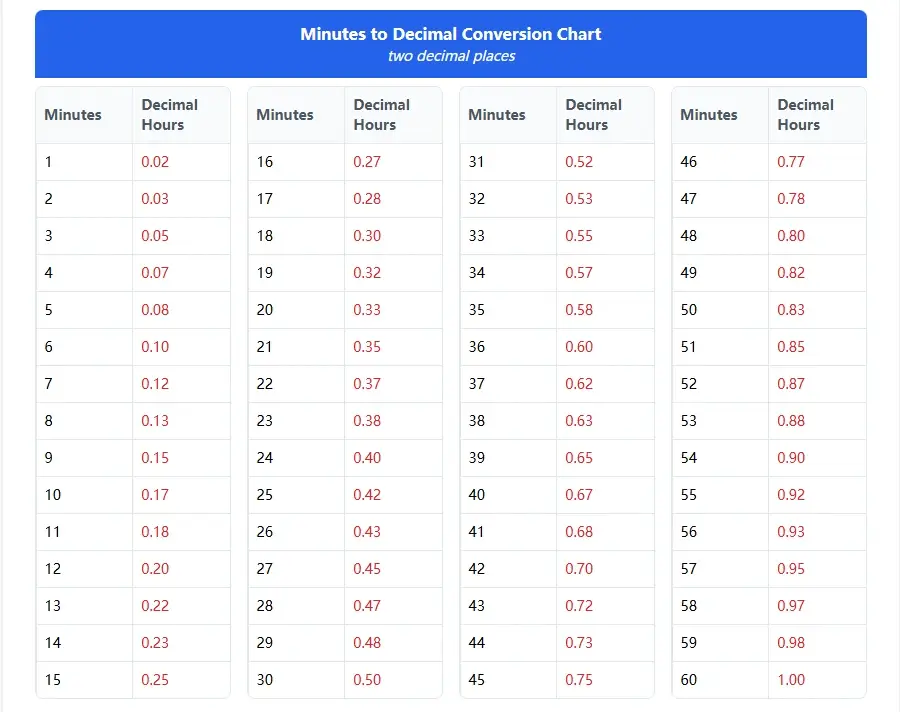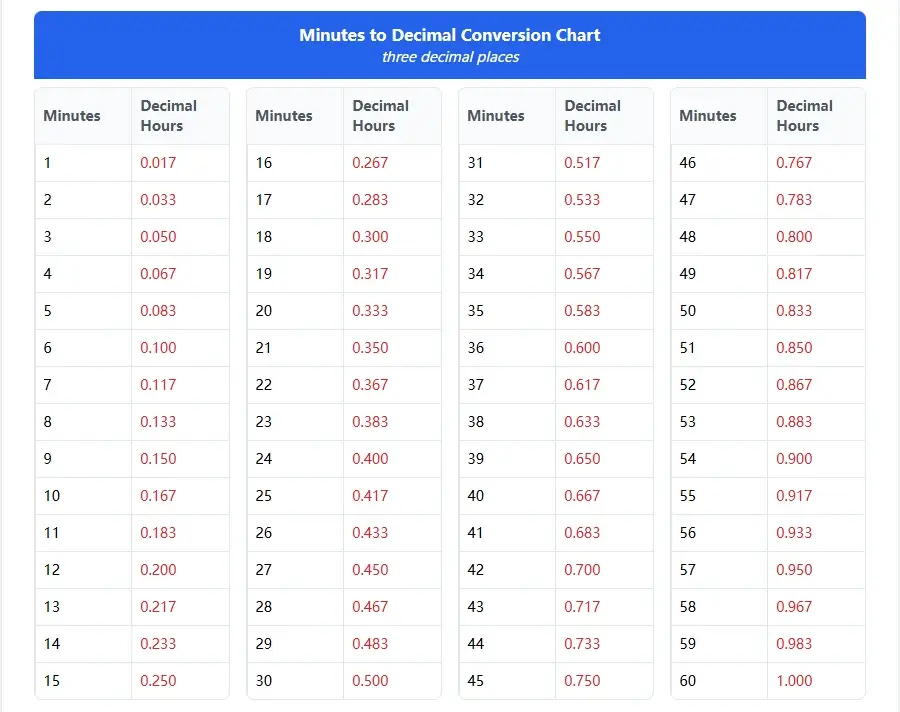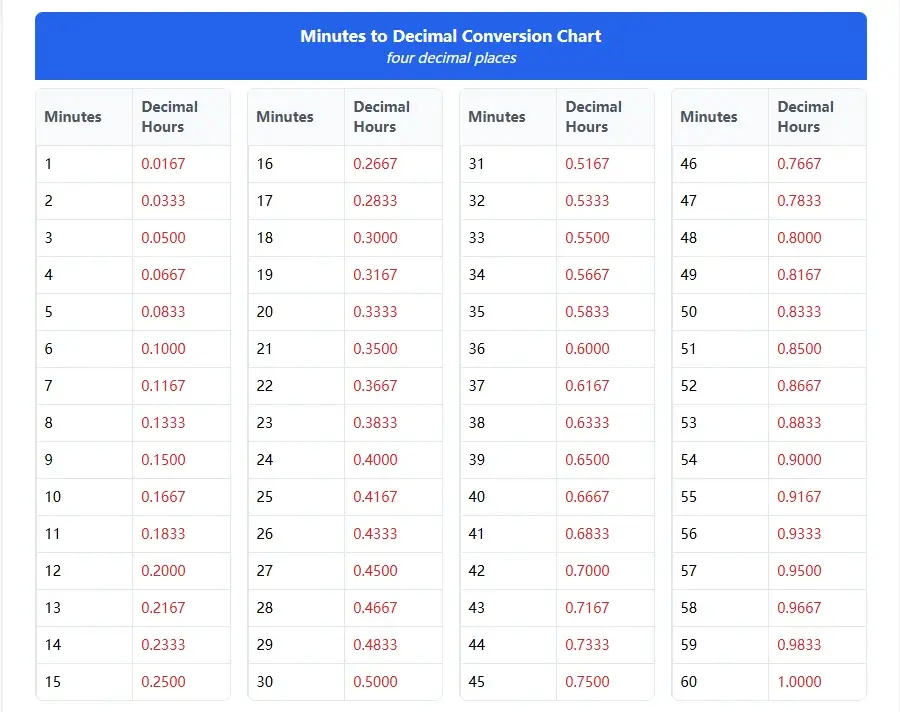Minutes to Decimal Hours Conversion Charts: The Complete Professional Guide
In today's precision-driven business environment, accurate time conversion isn't just a convenience—it's a competitive necessity. Minutes to decimal hours conversion charts serve as the cornerstone of professional time management, transforming complex calculations into streamlined operations that drive efficiency and eliminate costly errors. To complement these digital tools, we also offer a downloadable PDF version of the time conversion chart for minutes to decimal hours.
The Strategic Importance of Decimal Hour Conversion
The transition from traditional time notation to decimal hours represents more than a simple mathematical conversion—it's a fundamental shift toward operational excellence. When organizations embrace decimal time systems, they unlock unprecedented levels of accuracy in payroll processing, project management, and client billing.
Consider the financial impact: A single miscalculation in time conversion can cascade through an organization's entire billing system. For professional services firms billing at $200+ per hour, even a five-minute error translates to significant revenue discrepancies. Decimal hour conversion charts eliminate these risks by providing instant, accurate reference points that ensure mathematical precision across all time-related calculations.
Understanding Precision Levels: Choosing the Right Decimal Format
Two Decimal Places: The Business Standard
The two-decimal format (0.00) represents the gold standard for most business applications. This precision level strikes the optimal balance between accuracy and practicality, making it the preferred choice for:
- Standard payroll processing and wage calculations
- General project time tracking and reporting
- Basic client billing and invoice generation
- Employee attendance and overtime calculations
Two Decimal Places Minutes to Decimal Conversion Chart

Perfect for standard payroll systems and general business time tracking applications
Three Decimal Places: Enhanced Precision
When your operations demand higher accuracy, the three-decimal format (0.000) delivers the precision necessary for detailed analysis and specialized applications:
- Detailed project cost analysis and budgeting
- High-value consulting and professional services billing
- Performance metrics and productivity optimization
- Research and development time tracking
Three Decimal Places Minutes to Decimal Conversion Chart

Enhanced precision for detailed project analysis and high-value professional services
Four Decimal Places: Scientific Precision
For applications requiring absolute precision, the four-decimal format (0.0000) provides scientific-grade accuracy essential for:
- Manufacturing process optimization and quality control
- Scientific research and laboratory time measurements
- Precision engineering and technical applications
- Regulatory compliance and audit requirements
Four Decimal Places Minutes to Decimal Conversion Chart

Maximum precision for scientific research, manufacturing, and regulatory compliance
Industry-Specific Applications and Best Practices
Legal and Professional Services
Law firms and consulting practices rely on precise time tracking for client billing and profitability analysis. The three-decimal format provides the accuracy necessary for high-value engagements while maintaining the simplicity required for daily operations. Partners can confidently bill clients knowing that every minute is accurately converted and properly documented.
Healthcare and Medical Facilities
Medical professionals use decimal time conversion for staff scheduling, patient care documentation, and regulatory compliance. The two-decimal format typically suffices for most healthcare applications, though specialized research facilities may require three-decimal precision for clinical trial documentation and research protocols.
Manufacturing and Production
Manufacturing operations demand precise time measurements for production planning, quality control, and efficiency optimization. Four-decimal precision becomes essential when tracking machine cycles, process optimization, and lean manufacturing initiatives where seconds can impact overall productivity metrics.
Technology and Software Development
Software development teams use decimal time conversion for sprint planning, project estimation, and resource allocation. The flexibility to choose between two and three-decimal precision allows teams to match their tracking granularity to project complexity and client requirements.
Implementation Strategies for Maximum ROI
Organizational Standardization
Successful implementation begins with establishing organization-wide standards. Choose a single decimal precision level for each business function and ensure all team members understand the rationale behind these decisions. Consistency across departments eliminates confusion and reduces the likelihood of calculation errors.
Technology Integration
Modern time tracking systems should seamlessly integrate with your chosen decimal format. Configure software settings to match your conversion charts, ensuring that automated calculations align with manual references. This integration creates a cohesive system that supports both digital and analog time management approaches.
Training and Change Management
Invest in comprehensive training programs that help employees understand both the technical aspects of decimal time conversion and the business benefits it provides. When team members understand how accurate time conversion impacts their work and the organization's success, adoption rates increase significantly.
Advanced Conversion Techniques and Calculations
Bulk Time Processing
For organizations processing large volumes of time data, conversion charts enable rapid batch processing. Train accounting and payroll staff to use charts for quick verification of automated calculations, creating a dual-layer accuracy system that catches errors before they impact financial reporting.
Cross-Timezone Calculations
Global organizations benefit from decimal time conversion when coordinating across time zones. Converting meeting durations, project timelines, and collaborative work sessions to decimal format simplifies scheduling and resource allocation across international teams.
Performance Metrics and Analytics
Decimal time conversion enables sophisticated performance analysis that would be cumbersome with traditional time formats. Calculate productivity ratios, efficiency trends, and resource utilization metrics with mathematical precision that supports data-driven decision making.
Quality Assurance and Error Prevention
Verification Protocols
Establish systematic verification procedures that use conversion charts as reference standards. Regular spot-checks of automated calculations against chart values help maintain system accuracy and identify potential software configuration issues before they impact business operations.
Audit Trail Documentation
Maintain detailed documentation of conversion methods and chart usage for audit purposes. This documentation demonstrates due diligence in time tracking accuracy and provides transparency for clients, regulators, and internal stakeholders who require detailed time accounting.
Future-Proofing Your Time Management Systems
Scalability Considerations
As organizations grow, time tracking requirements become more complex. Conversion charts provide a scalable foundation that adapts to increasing data volumes and more sophisticated analysis requirements without requiring fundamental system changes.
Technology Evolution
While digital tools continue to evolve, the fundamental mathematics of time conversion remains constant. Conversion charts serve as reliable reference standards that remain valuable regardless of technological changes, ensuring long-term investment protection.
Measuring Success and Continuous Improvement
Key Performance Indicators
Track the impact of decimal time conversion implementation through specific metrics: reduction in billing disputes, improvement in payroll accuracy, decrease in time-related calculation errors, and increase in overall operational efficiency. These measurements demonstrate the tangible value of professional time management practices.
Ongoing Optimization
Regular review of conversion chart usage patterns reveals opportunities for process improvement. Analyze which precision levels are most frequently used, identify common conversion scenarios, and optimize chart accessibility to support the most critical business functions.
Conclusion: Transforming Time Management Excellence
Minutes to decimal hours conversion charts represent more than simple reference tools—they embody a commitment to operational excellence and precision that distinguishes professional organizations from their competitors. By implementing these charts strategically and supporting them with proper training and technology integration, organizations create sustainable competitive advantages through superior time management capabilities.
The investment in professional time conversion practices pays dividends through improved accuracy, enhanced efficiency, and reduced operational risk. As business environments become increasingly complex and competitive, the organizations that master fundamental operational elements like time conversion position themselves for sustained success and growth.
Ready to Implement Professional Time Conversion?
Experience the precision and efficiency of our interactive minutes to decimal hours converter, designed to complement these professional conversion charts.
Access Professional Converter